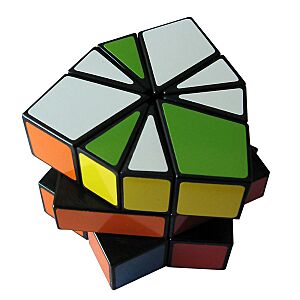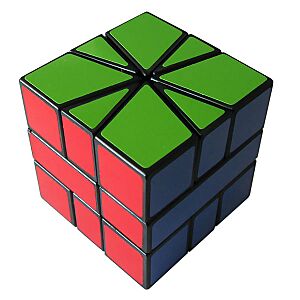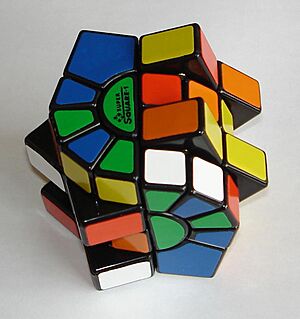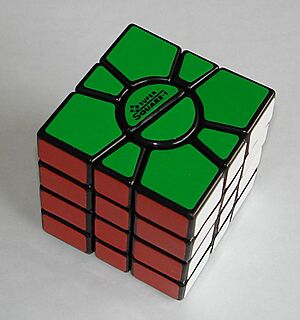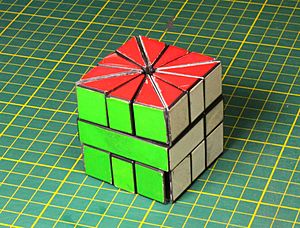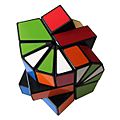Square-1 (puzzle) facts for kids
The Square-1 is a cool puzzle that's a bit like the Rubik's Cube. It's also known as Back to Square One or Cube 21. What makes the Square-1 special is that it can change its shape when you twist it. This happens because of how its pieces are cut. This unique feature makes it even more challenging and fun to solve!
There are also other versions of this puzzle, like the Super Square One and the Square Two. These puzzles add even more twists to the original design.
Contents
Amazing World Records
People love to solve the Square-1 as fast as they can! There are official competitions to see who is the quickest.
The fastest anyone has ever solved a Square-1 is 4.59 seconds. This amazing record was set by Martin Vædele Egdal from Denmark. He did it on September 5, 2020, at a competition in Roskilde, Denmark. Imagine solving a puzzle that fast!
The world record for the average of 5 solves is 6.54 seconds. This means they solve it five times, and then remove the fastest and slowest times to get an average. Vicenzo Guerino Cecchini from Brazil set this record. He achieved it at a competition in São Paulo, Brazil, in 2019.
Top 5 Fastest Solvers
Here are the top 5 people who have solved the Square-1 the fastest in a single try:
| Name | Fastest solve | Competition |
|---|---|---|
| Martin Vædele Egdal | 4.59s | Danish Championship 2020 |
| Jackey Zheng | 4.95s | Brooklyn 2019 |
| Tijmen van der Ree | 4.98s | Mental Breakdown Capelle 2019 |
| Vicenzo Guerino Cecchini | 5.00s | Schoolmark Open 2018 |
| Benjamin Gottschalk | 5.11s | Washington Championship 2020 |
Top 5 Average Solvers
These are the top 5 people with the fastest average times over 5 solves:
| Name | Fastest average | Competition |
|---|---|---|
| Vicenzo Guerino Cecchini | 6.54s | Bernô Feet Friendship 2019 |
| Rasmus Stub Detlefsen | 6.67s | Greve Gymnasium 2020 |
| Michał Krasowski | 6.74s | Dragon Cubing 2020 |
| Makoto Takaoka (高岡誠) | 7.09s | Kyoto Open 2019 |
| Aiden Bartlett | 7.10s | Washington Championship 2020 |
Super Square One Puzzle
The Super Square One is a bigger version of the Square-1. It has four layers instead of three. Just like the original Square-1, it can change into many different shapes when you twist it. As of 2009, you could buy this puzzle from Uwe Mèffert in his puzzle shop, Meffert's.
This puzzle has four layers, and each layer has eight pieces. These pieces move around a central column. This design lets you swap pieces between the top and bottom layers, and also between the two middle layers. Each layer has four wider pieces and four narrower pieces. In the top and bottom layers, the wider pieces are like "corners," and the narrower pieces are like "edges." In the middle layers, it's a bit different: the wider pieces are "edges," and the narrower ones are "face centers." The wider pieces are exactly twice the size of the narrower ones, so two narrower pieces can fit where one wider piece would go. This is why the puzzle can make so many wild shapes!
How to Solve the Super Square One
Even though the Super Square One looks more complicated, it's not much harder to solve than the original Square-1. The middle layers are very similar to the top and bottom layers of the regular Square-1. You can solve them using the same steps you would use for the smaller puzzle. The edges in the middle layers are special because if they have the same two colors, they are mirror images of each other. However, the center pieces of each face can be swapped around because they only show one color.
Square Two Puzzle
The "Square Two" is another cool version of the popular Square-1 puzzle. It has extra cuts on its top and bottom layers. You can also find this puzzle sold by Meffert's online store.
The Square Two works mechanically just like a Square-1. However, the big corner pieces on the top and bottom layers are cut in half. This makes these corner pieces as flexible as the edge pieces. This design actually makes the Square Two easier to solve and scramble than the original Square-1. It removes a common problem where the Square-1 can "lock up" and prevent certain turns.
How to Solve the Square Two
The Square Two, like the Super Square One, isn't much harder than the Square-1. In fact, it can be easier because you can always make a slice turn, no matter how the top and bottom layers are positioned. You mostly solve it just like the original Square-1. The main extra step is putting the corner pieces back together. After that, it's exactly like solving a regular Square-1.
How Many Ways Can It Be Mixed Up?
There are 24 wedge pieces on the Square Two puzzle. These pieces can be arranged in almost any order. This means there are an incredibly huge number of ways the puzzle can be mixed up!
The total number of possible positions for the Square Two puzzle is 8,617,338,912,961,658,880,000. That's a massive number, showing just how many different ways the pieces can be arranged!
Images for kids
See also
 In Spanish: Square One (puzzle) para niños
In Spanish: Square One (puzzle) para niños


